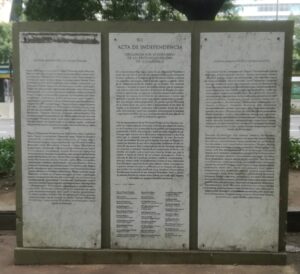Thanks to a raid carried out in Buenos Aires, the Peruvian government managed to recover an ancient and valuable book published in 1772, stolen from a public library in that country. The episode once again highlighted the effective and constant task of surveillance and custody of its cultural heritage carried out by the authorities of the sister nation. Peru has stood out for years due to its active international policy of recovering goods of historical or artistic value that, as a result of looting or theft in that country and evading customs controls, are then offered for sale in the rest of the world.
But just as what happened demonstrates the value that a policy like Peru’s acquires over time, it also has the virtue of highlighting the improvisational and risky conduct of our authorities on similar issues and their clumsy ignorance.
In effect, after that same search, the Argentine customs authorities announced with indisputable fanfare “the recovery of the original Act of the Declaration of Argentine Independence”, as some media related to the ruling party, always quick to applaud and slow to criticize, repeated.

Painting on the ceiling of the Salón Blanco de la Casa Rosada in Buenos Aires, the office of the president of Argentina, with an allegory of the May Revolution and Declaration of Independence of 1816.
A careful analysis of the issue reveals a sad reality that, as is often the case with many government acts these days, is far from the almost epic description formulated by the authorities.
In their eagerness to build a story capable of hiding the unfortunate nature of its administration and concealing the errors, confusions and bad practices that distinguish it, the authorities have once again falsified reality.
The original of the Act of the Declaration of Independence has been missing for many years. There are, yes, typographical versions of that document. The first of them were sent to print in 1816 with print runs that did not exceed 1,000 or 2,000 copies. They obviously have enormous historical importance, but never comparable to that of the lost original.
Of the total printed, over more than two hundred years some copies were lost or destroyed; many of those that survive are in the hands of museums or public institutions. Others, on the other hand, are and have always been in private hands, because that was their original destination: to be distributed among the population of the then United Provinces to publicize what happened in a simple Tucuman house on July 9, 1816.
To say then, as the General Directorate of Customs has done, that this agency “rescued the document” is fallacious, since it is more than likely that it has never been in state hands. And there is no rule that prohibits its ownership by individuals. “Rescuing”, “rescate,” according to the Royal Spanish Academy is “recovering by price or by force what the enemy has captured or anything that is in someone else’s hands at the hands of another.” In this case, nothing seems to indicate that a previously public property has irregularly fallen into the hands of third parties.
Not only was there no such “rescue” (nor did it respond to an act of thoughtful cultural policy as the result of careful planning such as the one carried out by the Peruvian authorities), but the Argentine officials, in addition to repeating such nonsense, also proclaimed that the unexpected “recovery” of the document “was an act of national sovereignty.” There is a serious conceptual distortion here, the result of the government’s repeated intention to dress up another of its many errors by disguising it as correct and try to surprise public opinion with high-impact phrases.
To recover something is to take back or acquire what was previously had and, once again, this does not seem to be the case. Like it or not, there is no legal provision in Argentina that obliges that this reprint of the Independence Act must be in the possession of the State or that obliges an individual to part with what they may possess.

Portrait of José de San Martín, said to be the work of Jean Baptiste Madou, 1829 or 1827. Collection of the San Martin National Institute.
Despite the existence of various laws for the protection of the Nation’s cultural assets, they were never complied with. The survey, cataloging and identification of said assets in private hands has never occurred. That is why our country ‒except for paleontological or archaeological pieces under Law 25,743‒ lacks a list of individualized objects whose commercialization is prohibited based on their historical or artistic relevance. It also lacks objective parameters to qualify them as such.
There are, yes, customs restrictions for leaving the country, but according to the narration made by the authorities themselves, the “rescued” and “recovered” document was not about to cross any border and was offered for sale in a business open to the public.
It is worth repeating that the country has never enacted any law that has provided for the expropriation of documents of this type or similar assets or that has made their possession in private hands a crime. There are rules that impose the creation of a National Registry of Cultural Assets, but these refer to those that are in public hands. Others (such as those referring to the powers of the National Commission of Monuments, Places and Historical Assets) allow that body to declare certain assets as “of national historical interest” ‒which would effectively prevent their sale without the prior permission of that body‒, but such declarations are made on a case-by-case basis and this, in relation to these documents, has not happened. The Commission also has the legal power to “propose to the Executive Branch the acquisition of private property when it is in the public interest to enter the domain of the national State,” but not to appropriate it under misleading references to alleged “rescues” or “recoveries.”

1816 Independence Declaration of Argentina. Monument Text. At 9 de Julio Av, Buenos Aires. The text of the Declaration is written in three languages: Aymara, Quechua and Spanish, each panel with each language. Photo by Roblespepe, 27 May 2019, CCA-SA 4.0 International license.
Other regulations (such as Law 27,522) oblige dealers in antiques and works of art to register as such and register their operations. The description of what happened does not mention a possible violation of these rules and, even if they had occurred, the sanctions that this law imposes fall on the people involved, but do not imply the appropriation of the goods in question (even when it is called “rescue” or “recovery”).
Pretending to turn what happened into an “act of national sovereignty” sounds like clumsy or ignorant bungling. Sovereignty consists precisely in the opposite: in the ability to apply one’s own laws not beyond their correct scope and to comply with them and enforce them; not in justifying the absence of patrimonial policies with acts of abuse and dispossession that will later give rise to the payment of compensation.
What happened is clear evidence that Argentina lacks adequate legislation to protect its cultural heritage. And while it lacks it, that heritage will continue to be at risk and slowly disappearing.
Juan Javier Negri is an Argentine lawyer practicing in Buenos Aires. He holds a law degree from the University of Buenos Aires and a Master in Comparative Law degree from the University of Illinois College of Law. He is Chairman of the Board of Trustees of Fundación Sur, an organization preserving the history and creative works of 20th. century South American writers and artists. In 2015 he received the Uría Meruéndano Art Law Award granted by the Uría Foundation (Madrid) for his book Banksy’s door: an essay on mistake and error in the purchase of artworks. In 2017 he was appointed to serve on the Board of Directors of the Fondo Nacional de las Artes, an autonomous state agency to provide financial assistance to artists and arts projects. Since January 2012, he is included in the Geneva-based WIPO List of Neutrals for Art and Cultural Heritage. He is also a member of the Court of Arbitration for the Arts, The Hague and the president of the Argentine Association of Comparative Law. He writes extensively on art law and cultural matters.
 1816 Independence Declaration of Argentina, July 9, 1816, detail.
1816 Independence Declaration of Argentina, July 9, 1816, detail. 

